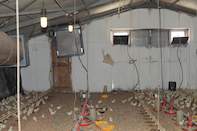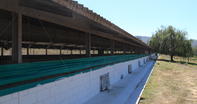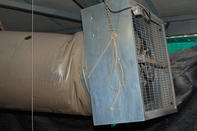
Ventilation
According to Ross’s Broiler Handbook, ventilation is the main way of controlling the birds’ environment: It helps to maintain acceptable air quality while removing moisture, limiting the build-up of potentially harmful gasses and keeping birds within comfortable temperatures. During the early stages of the birds’ life, it supplies heat to keep them warm and comfortable, and provides sufficient fresh air to maintain an acceptable air quality in the house. As the birds grow older and start to produce more heat, higher ventilation rates are needed to remove heat and the products of respiration from the house. There are two types of ventilation, according to Ross.Natural Ventilation

Natural ventilation is when you have an open sided house, with curtains, flaps or door on the sidewalls. These curtains or flaps are opened or closed to manipulate airflow in and out of the house.
Fans may be used to circulate and evenly distribute the air within the house. Some producers use heaters to raise temperatures or foggers (water sprinklers) to lower temperatures.
It is difficult to manipulate climatic conditions in a house using this system, because the house is so exposed to outside temperatures. According to Ross, natural ventilation works best when outside temperatures are close to the required temperatures inside the house.
Closed Environment Ventilation
These powered ventilation systems are used in houses that either have solid sidewalls or curtains that are kept closed during operation. Fans and inlets are used to ventilate the house. It is more expensive but allows producers greater control over climatic conditions in the houses.Relative Humidity

Relative humidity refers to the water vapour content in the air. When heaters are used it usually causes humidity levels to drop, which in turn results in humans struggling with dry skins and noses.
In chicken humidity levels below 30% will dry out their respiratory systems and result in birds becoming more susceptible to respiratory diseases. The birds will also become more agitated and aggressive, according to Hyline.
High humidity levels, on the other hand, create ideal breeding grounds for all kinds of moulds, mildews and bacteria. The relative humidity in a poultry house should ideally range between 40% and 60% when chicks are small.
Birds add to humidity levels through their breathing and droppings. So what can be done to reduce humidity levels?
- Use the correct stocking densities. (Read more about this.) The more birds you have per square meter the more droppings and respiration produced per square meter.
- Manage bedding properly to reduce moisture levels. If you do not use bedding, remove droppings regularly from the production area.
- Use the right depth of bedding. Winter bedding should generally be thicker than summer bedding.
- Ensure there are no leakages in the houses. Evaluate drinkers, pipes and the building and fix leaks as soon as they are spotted.
- Birds should be on a balanced diet and kept healthy to prevent diarrhoea.
What can be done to raise humidity levels?
- Floor surfaces can be sprayed with water.
- Foggers or water sprinklers can be used to add moisture to the air.